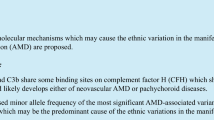Background: North Carolina macular dystrophy (NCMD) is a rare autosomal dominant maculopathy with highly variable expressivity. Genetic analysis of an American family consisting of 247 members out of which 96 were affected with NCMD allowed chromosomal assignment of the NCMD locus to 6q14-q16.2. Few families with NCMD are known in Europe, one of these is living in Germany. By routine investigation, a second family affected with NCMD was detected in Germany. As some authors still doubt the good prognosis of this disease, our results should be added to the experience of others.
Patients and methods: In a total of 18 family members from three generations between the age of 2 and 65 years, clinical investigations and genetic analysis was carried out. Some individuals had additional examinations such as colour contrast sensitivity, EOG, ERG, and microperimetry.
Results: Ten of 18 family members turned out to be affected. All grades of NCMD were present with great variability. Visual acuity ranged from 0.32 to 1.0 and did not correlate to the grade of the disease or to the age of the person. In those patients who underwent microperimetry, central fixation was confirmed. Genetic linkage analysis further narrowed the region harbouring the NCMD locus and supported the assumption that the central areolar pigment epithelial dystrophy (CAPED) is an allelic disorder.
Conclusion: Similar visual acuity in three generations of NCMD patients supports the observation that NCMD is not a progressive disorder. If geographic atrophy is found in a patient with good visual acuity, NCMD should be considered and genetic analysis should be carried out.
Fragestellung: Die North-Carolina-Makuladystrophie (NCMD) ist eine seltene autosomal-dominante Makulopathie mit stark variabler Expressivität. Aus 247 Mitgliedern einer amerikanischen Familie ist die genetische Zuordnung auf Chromosom 6q14-q16.2 gelungen. In Europa sind nur wenige Familien bekannt, davon bislang 1 in Deutschland. Aufgrund eines Zufallsbefunds konnte eine 2. Familie in Deutschland mit NCMD entdeckt werden. Da mitunter noch Zweifel hinsichtlich der Prognose geäußert werden, sollen die Befunde der betroffenen Familienmitglieder vorgestellt werden.
Patienten und Methode: 18 Familienmitglieder im Alter von 2–65 Jahren aus 3 Generationen wurden klinisch und molekulargenetisch untersucht. Bei einzelnen Betroffenen wurden zusätzliche Tests, wie Farbensehen, EOG, ERG und Mikroperimetrie, durchgeführt.
Ergebnisse: Von den 18 Mitgliedern waren 10 betroffen. Alle Ausprägungsgrade der NCMD waren in starker Variabilität vertreten. Der Visus der Betroffenen lag zwischen 0,32 und 1,0 und korrelierte nicht mit dem Ausprägungsgrad oder dem Alter. Mikroperimetrisch konnte bei den untersuchten Personen zentrale Fixation nachgewiesen werden. Mittels Kopplungsanalyse konnten die Lokalisation des NCMD-Gens weiter eingegrenzt und die Annahme der Allelie zur zentralen areolaren Pigmentepitheldystrophie (CAPED) unterstützt werden.
Schlußfolgerung: In allen 3 Generationen vergleichbare Angaben zur zentralen Sehschärfe bestätigen die Annahme, daß die Erkrankung keine Progredienz aufweist. Beim Aspekt einer geographischen Atrophie mit gutem Visus sollte an eine NCMD gedacht und eine genetische Untersuchung durchgeführt werden.
Similar content being viewed by others
Author information
Authors and Affiliations
Rights and permissions
About this article
Cite this article
Schworm, H., Ulbig, M., Hoops, J. et al. North Carolina macular dystrophy: a hereditary macular dystrophy with good visual prognosis. Ophthalmologe 95, 13–18 (1998). https://doi.org/10.1007/s003470050229
Issue Date:
DOI: https://doi.org/10.1007/s003470050229




